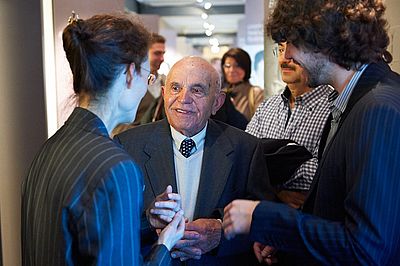FAQ
About this exhibition
Until today the history of the approximately 650,000 Italian military interned (IMI) in Germany is little known. In 1943 they were deported by the Wehrmacht as prisoners of an allied army and used for forced labour in the German Reich and the occupied territories.
In December 2012, a German-Italian commission of historians in Rome presented the foreign ministers of both countries with a report containing recommendations for a "common culture of remembrance". The establishment of the Commission was the result of years of disputes over the compensation of former forced labourers. This was to come to an end with the establishment of the Foundation "Remembrance, Responsibility, Future" in the year 2000. However, the former military internees remained unnoticed as "prisoners of war" in the planned compensation payments. Numerous protests and the deterioration of German-Italian relations were the result.
In 2012, the Commission recommended that the largest German project be a permanent exhibition on the fate of Italian military internees. The Documentation Centre for Nazi Forced Labor in Berlin-Schöneweide was proposed as a suitable location. Since 2016, the exhibition "Zwischen allen Stühlen. Die Geschichte der italienischen Militärinternierten 1943-1945" ("The History of the Italian Military Interned 1943-1945") on this little-known chapter of the Nazi past. With visits by contemporary witnesses of former military internees and international youth encounters, the Documentation Centre also promotes critical discussion of the topic and strengthens public awareness of the German-Italian past and present. No financial compensation has yet been paid to those affected, and their forced labour has not been officially recognised as such by the Federal Republic of Germany.
Who were the Italian military internees?
After the armistice of 8 September 1943, the Wehrmacht occupied the Italian mainland. The Italian military were initially considered prisoners of war. At the end of September the fascist Repubblica Sociale Italiana (RSI) was founded. The satellite state, limited to northern and central Italy, remained an ally of the German Reich under Mussolini's leadership until the end of the war. However, military members of an allied state could not be prisoners of war. Therefore Hitler changed their status at the end of September 1943 and declared them military internees.
Forgotten victim group in Germany
For a long time in Germany and Austria only graves reminded of the Italian military internees and forced labourers who died in 1943-1945. Forced labour was considered a "normal" concomitant of war and occupation. It was not until the 1990s that history workshops and local initiatives began researching the history of deported soldiers and their places of detention and work. Memorials at the sites of former prisoner-of-war camps and the Nazi Forced Labour Documentation Centre in Berlin now pay tribute to the history of the internees.
You know a former IMI?
The aim of our work is to constantly contribute to an improvement of the research situation on the history of Italian military internees. If you have personal testimonies or testimonials of former military internees, you are welcome to contact us directly.
Contakt: Daniela Geppert, geppert(at)topographie.de
Archiv: N.N., schoeneweide(at)topographie.de

